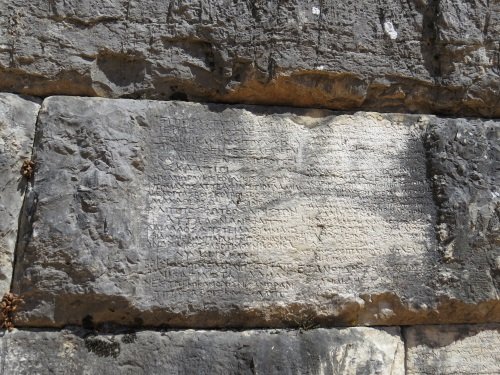Butrint
lies just across the Straits of Corfu from my previous destination, the
Old Town of Corfu
. It’s an easy trip out there from the Ionian Island: daily hydrofoils and ferries ply the route to the Albanian resort of Sarande, from where an hourly local bus heads out to Butrint 30km south. The WHS covers an archeological site that spans a long period, with mainly Greek, Roman and Byzantine remains. It also seems to have been renominated in 1999 as a cultural landscape, although UNESCO does not list it as such.

|
|
Remains of a column in the Theatre
|
During the high season the site can be crowded with daytrippers from Corfu, but fortunately I arrived early in the season. After paying the 700 lek entrance fee (5 EUR), I headed out on the forest path that connects the ruins. This shady environment was the first surprise of my visit: it’s a pleasure just to walk here, and I heard birds singing all the time. The natural area of Butrint also is awarded
Ramsar wetland status
.
The wetness of the area clearly shows at the first major archeological group: the former Greek sanctuary and theatre can only be entered via a boardwalk, and I noticed frogs in the Roman baths. Here’s where the origins of the site are, Butrint was founded as a sanctuary to Asklepios the Greek god of medicine. Visitors even freed some of their slaves to persuade the gods to help them – and they testified to that by carving inscriptions into the theatre’s walls. These can still be seen in situ. In hindsight this area probably was the most interesting part of the circuit.

|
|
Greek inscriptions about freed slaves
|
I had the site mostly to myself. I passed a series of Ancient Greek, Roman and Byzantine constructions, much like those at other classical sites that I have visited around the Mediterranean. A lot of mosaics have been discovered here too, but the Albanian authorities have covered them from the elements by plastic sheets and sand or pebbles. This is a pity as the mosaics would add something extra to this site, but the wet surroundings just seem to prevent this.
The path eventually turns uphill, towards what once was the Acropolis. You enter that area via the ‘Lion’s Gate’, a stone structure with a bas relief of a
lion devouring the head of a bull
. The lion relief was not part of the original wall or gate, but was found elsewhere in Butrint and may date to the 6th century BC. The circuit ends at a building from the Venetian period, which now houses the slightly disappointing site museum.

|
|
View on Lake Butrint
|
The WHS of Butrint was extended in 1999 to include the natural surroundings such as a range of hills to the north, the Butrint plain, Lake Bufit, and part of Lake Butrint. At the same time it was turned from 'just' a site into a cultural landscape. I think including its natural features was a good decision, as they are such a prominent part of a visit here. There are fine views on the surrounding lakes (Butrint lies on a peninsula) from the path across the site, and there are benches to sit on and enjoy the landscape. I found it a very peaceful site, I saw no traces of the turbulent times in the late 1990s when Butrint suffered from looting due to the civil disturbances in Albania.



